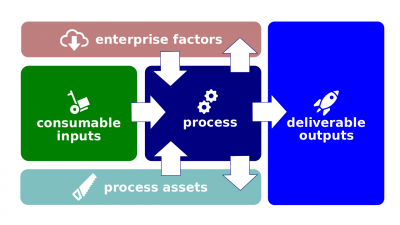Difference between revisions of "Process"
(→Definitions) |
(→Related lectures) |
||
| (One intermediate revision by the same user not shown) | |||
| Line 9: | Line 9: | ||
According to the [[BABOK Guide|BABOK Guide (3rd edition)]], | According to the [[BABOK Guide|BABOK Guide (3rd edition)]], | ||
:[[Process]]. A set of activities designed to accomplish a specific objective by taking one or more defined inputs and turning them into defined outputs. | :[[Process]]. A set of activities designed to accomplish a specific objective by taking one or more defined inputs and turning them into defined outputs. | ||
| − | According to the [[ INCOSE Systems Engineering Handbook (4th edition)]], | + | According to the [[INCOSE Systems Engineering Handbook (4th edition)]], |
:[[Process]]. A set of interrelated or interacting activities that transforms inputs into outputs (adapted from ISO 9001:2008). | :[[Process]]. A set of interrelated or interacting activities that transforms inputs into outputs (adapted from ISO 9001:2008). | ||
According to the [[ITIL Foundation 4e by Axelos]], | According to the [[ITIL Foundation 4e by Axelos]], | ||
| Line 20: | Line 20: | ||
*[[Effort Engineering Quarter]]. | *[[Effort Engineering Quarter]]. | ||
| − | [[Category: Septem Artes Administrativi]][[Category: Articles]][[Category: Quality Management]][[Category: Business Analysis]][[Category: Systems Engineering]] | + | [[Category: Septem Artes Administrativi]][[Category: Articles]][[Category: Quality Management]][[Category: Business Analysis]][[Category: Systems Engineering]][[Category: Information Technology]] |
Latest revision as of 17:25, 11 December 2020
Process (hereinafter, the Process) is a sequenced series, predefined, empiric, and/or merely chaotic, of activities undertaken in order to achieve particular results. Effort engineering defines that those activities convert inputs into desired outputs utilizing some process assets such as tools and techniques and while being influenced by some enterprise factors.
Definitions
According to Organizational Behavior by Robbins and Judge (17th edition),
- Process. An action that individuals, groups, and organizations engage in as a result of inputs and that leads to certain outcomes.
According to Juran's Quality Handbook by Defeo (7th edition),
- Process. Set of interrelated resources and activities that transform inputs into outputs.
According to the BABOK Guide (3rd edition),
- Process. A set of activities designed to accomplish a specific objective by taking one or more defined inputs and turning them into defined outputs.
According to the INCOSE Systems Engineering Handbook (4th edition),
- Process. A set of interrelated or interacting activities that transforms inputs into outputs (adapted from ISO 9001:2008).
According to the ITIL Foundation 4e by Axelos,
- Process. A set of interrelated or interacting activities that transform inputs into outputs. A process takes one or more defined inputs and turns them into defined outputs. Processes define the sequence of actions and their dependencies.
Repetative vs ad-hoc
Processes may be repetitive or ad-hoc ways of work. Non-repetitive processes are called management processes. Repetitive processes that are performed by people for enterprises are called business processes; those of their sets that produce a deliverable are called operations. Repetitive processes that are performed by systems including computers, robots, and/or machines are called system processes.
